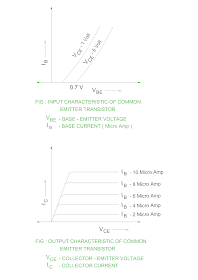Common Emitter
Configuration
- As the emitter terminal is common to both input and output of the transistor, it is called as Common Emitter Configuration.
- The input voltage VBE is applied between base and emitter terminal whereas the output is taken from collector and emitter terminals.
- The common emitter configuration for NPN transistor is shown in the Figure.
Current
Amplification Factor
- It is defined as the ratio of the output current ( collector current ) and input current ( base current ).
- It is ratio of the change in collector current to the change in base current.
β = dIC / dIB
- As the collector current is greater than base current, the current amplification is greater than unity.
- The range of current amplification factor ( β ) lies in the rage of 20 to 500.
Expression of
Collector Current
- The collector to emitter junction is reverse biased, therefore the collector current flows due to minority charge carriers. This current is called as leakage current.
- Total collector current
IC = βIB
+ ILEAKAGE
- As the base is open circuited, small leakage current flows in the collector circuit. This leakage current is called as ICEO.
ICEO
= Collector to emitter current with base open
IC = βIB
+ ICEO ……… ( 1 )
In the CB
configuration
As IE
= IC + IB
IC =
αIC + αIB + ICBO
IC – αIC = αIB + ICBO
IC (
1 – α ) = αIB + ICBO
IC =
αIB / ( 1 – α ) + ICBO / ( 1 – α )………….. ( 2 )
Comparing
Equation ( 1 ) and ( 2 )
β
= α / ( 1 – α ) and ICEO = ICBO / ( 1 – α )
|
The value of ICEO
is much larger than ICBO.
- Total Emitter Current
As IE
= IC + IB…………. ( 3 )
From equation (
1 ) and ( 3 )
IE =
βIB + ICEO + IB
IE =
( β + 1 )IB + ICEO
IE
= ( β + 1 )IB + ICEO
|
Characteristic
of CE Transistor Configuration
Input
Characteristic
- It is relation between base current and emitter – base voltage at constant collector – emitter voltage.
- The base current is taken along Y – axis and emitter – base voltage is taken along X – axis.
Key Points
- As there is small increase in input emitter – base voltage, the base current increases very rapidly ( higher than CB transistor configuration ). Therefore the input resistance of CE transistor is higher than the CB transistor configuration.
- The input characteristic of CE transistor is close to that of PN junction diode.
Input resistance
= dVBE / dIB
Output
Characteristic
- It is relation between collector current and collector – emitter voltage at constant input current ( Base current ).
- The collector current is taken along Y – axis and collector – emitter voltage is taken along X – axis.
Key Points
- As the collector – emitter voltage increases, the collector current becomes almost constant.
- It means that the output or collector current does not depend upon collector – emitter voltage but it depends upon input current or base current.
- As the base current increases, the collector current also increases. As the change in collector to emitter voltage is very large, there is no change in the collector current it means that output resistance is very high.
- The collector to emitter voltage at which collector current changes, it is called as KNEE VOLTAGE.
- The transistor is always operated above knee voltage.
Output
resistance = dVCE / dIC at constant IB
- There is some slope in the output characteristic of CE transistor configuration therefore its output resistance is less than that of CB transistor configuration.
Describe
the range of current amplification factor for common base configuration.
- 20 to 500
What
do you mean by ICEO?
- It is leakage current, the ICEO indicates that the output or collector current flows when emitter to base junction ( input ) is open circuited.
Why
the output resistance of CE transistor is less than that of CB transistor?
- The output characteristic of CE transistor has some slope as compared to CB transistor which is almost flat therefore the output resistance of CE transistor is less than that of CB transistor.
Why
the input resistance of CE transistor is higher than that of CB transistor?
- The input base current of the CE transistor increases less rapidly than that of CB transistor therefore the input resistance of CE transistor is higher than that of CB transistor.
You may also like :


No comments:
Post a Comment